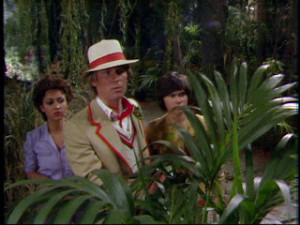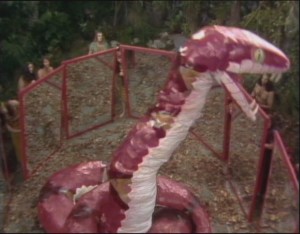 The TARDIS lands in the Garden of Eden, almost literally— although the story is based on Buddhism rather than Genesis. Kinda is an unusual story for Dr Who, having more to do with philosophy than adventure, and although the obligatory monster puts in an appearance at the end, it’s largely a peripheral presence for most of the story.
The TARDIS lands in the Garden of Eden, almost literally— although the story is based on Buddhism rather than Genesis. Kinda is an unusual story for Dr Who, having more to do with philosophy than adventure, and although the obligatory monster puts in an appearance at the end, it’s largely a peripheral presence for most of the story.
The planet Deva Loka has a perfect climate, with the temperature varying no more than 5 degrees from high to low. There are no predatory life forms. The weather is mild. The trees produce abundant edible fruit year-round. So the local intelligent life form has no need for shelter, no worries about food or any other shortages, and nothing to fear. Perhaps it’s not surprising that they’ve never developed technology nor any kind of government or civilization, and are culturally so non-aggressive they don’t even understand hostility when they encounter it.
As the story begins, it looks like it’s going to be an allegory of European colonialism. An expedition from a technologically advanced civilization has landed on the planet to evaluate it for colonization, and although their homeworld is never named (they call it “Mother Planet”) their military uniforms are designed to look like those of the nineteenth century British in India. The expedition leader, Saunders, is casually dismissive of the “natives”— when the expedition scientist points out that from the Kinda’s point of view they would be considered hostile, he doesn’t even understand what she’s talking about. “What do you mean?” he asks. “They’re primitives, how could they have a point of view?”
But the story soon takes a surprising turn in a different direction. Three of the six expedition members have disappeared. Security chief Hindle is desperately clinging to the regulations for precautions while Saunders, given the general benevolence of the planet, is inclined to think there’s just been an unlucky accident, or perhaps a desertion or two. When he leaves Hindle in charge while he goes out to search for the missing people, it immediately becomes clear that Hindle’s been on the verge of a nervous breakdown, and once he’s left in charge he snaps completely. The Doctor, Adric and the expedition scientist are trapped at the mercy of a madman as Hindle becomes one of the scariest non-alien monsters Dr Who’s ever presented. He’s not really a villain— in fact you feel sorry for him more than anything else— and yet at the same time he’s terrifying. The situation plays well to the Fifth Doctor’s vulnerable persona: the Doctor, in any regeneration, is used to out-thinking and out-maneuvering his adversaries but he’s helpless to figure out how to handle this one, because Hindle’s madness is unpredictable and uncontrollable. We watch the Doctor trying hard to figure out any kind of underlying logic to Hindle’s paranoia, something he can work with, but there’s nothing there— and Hindle threatens a homicidal rage at every mistaken syllable or incorrect question.
Meanwhile, outside in the jungle the wise woman of the Kinda is desperate to contact the “not-we” and tell them to leave before they trigger something terrible, and Tegan (separated from the Doctor and Adric) has been possessed by an evil spirit called the Mara (the Buddhist version of the devil), which soon leaves her and takes over one of the Kinda. The Mara wants to teach the Kinda all about hostility, war and killing— and so start the “wheel of history” turning again. We learn that Deva Loka’s paradise is not a primeval garden after all, but that the planet’s history is a series of endless cycles in which the Mara kicks off the rise of civilization, marked by bloodshed and war and all sorts of other evils, until it all finally ends in terrible suffering, disaster and collapse. Then paradise returns— until the next time. The Doctor’s parts as well as the explorers have, between them, provided the occasion for the Mara to start the wheel once more, and it’s up to the Doctor to stop it in time.
Kinda is a divisive story among fans: some like it for its philosophical bent, some dislike it for the same reason (A pair of philosophers once wrote a book allegedly on philosophy in Dr Who, Doctor Who: The Unfolding Text, but used Kinda as almost their exclusive source material). On the whole, it’s rather un-Doctor-Who-like, although taken as a story on its own terms I think it works rather well. Of the two main threads, the Hindle story is better— which is a flaw because it’s really the Mara story that is supposed to be the main focus. Tegan spends half the story locked in a dream state where the Mara tries to force her to let it possess her, and that part’s just strange. Then, actress Janet Fielding does a very good job playing Tegan possessed by the Mara, making a very creepy villain for a short time, but she’s only allowed to do it briefly before the Mara jumps into a Kinda named Aris, who unfortunately turns out to be rather silly.
Still, overall I like this episode— but I wouldn’t want to see all of Dr Who take this path. There’s a touch of irony in the fact that by defeating the monster, the Doctor has ensured that Deva Loka will be a place he’d find too boring to visit— and he departs with the line, echoing what the expedition scientist has just said, “I think paradise is a little too green for me as well.”
Details
 The final appearance of the Mara in its true, giant-snake form, is one of the most infamous disappointing monster effects in Dr Who’s history. As seen at right, it turns out to be a very unconvincing hot pink plastic puppet. The DVD release includes the option to replace it with a new CGI effect which certainly looks much better, although on the whole I’m in favor of watching the Classic episodes as they originally were.
The final appearance of the Mara in its true, giant-snake form, is one of the most infamous disappointing monster effects in Dr Who’s history. As seen at right, it turns out to be a very unconvincing hot pink plastic puppet. The DVD release includes the option to replace it with a new CGI effect which certainly looks much better, although on the whole I’m in favor of watching the Classic episodes as they originally were.- New series writer Robert Shearman has an interesting take on the snake in Kinda, however. Recalling how he watched the story as a child, he proposes that audiences have not simply become “more sophisticated” in their expectation from special effects, as if often said, but rather that while modern audiences expect the screen to show them what they’d see if the story really happened and they were really there, audiences back in the day— or at least children like Shearman was— understood that special effects were like a description in a book, meant to stimulate your imagination to fill in what they couldn’t show.
- Coming off the cliffhanger ending of last week’s story, when Nyssa collapsed evidently from exhaustion or stress, the Doctor prescribes 48 hours sleep under a “delta wave augmenter.” The result is that Nyssa is absent from this story after a brief opening scene, and was a response of the producers to the problem of the over-crowded TARDIS.
- This story does not end with a cliffhanger into the next. Has John Nathan-Turner dropped the idea of an “ongoing serial” after just one try? To be continued next week.
- The Doctor uses his sonic screwdriver as a component of the delta wave augmenter, and so is without it when, later, it would have come in handy getting out of the cell Hindle locks him and Adric into. John Nathan-Turner had decided that writers had begun using the screwdriver as a crutch to get the Doctor out of scrapes, in lieu of clever writing, and wanted to phase it out. It’s a somewhat ironic development: compared with the new series, the sonic screwdriver was hardly used at all in Classic (and usually only for plausible things you might use a screwdriver, sonic or otherwise, for: picking locks, opening panels, and so on). Even without a comparison to the new series, I wouldn’t say the sonic screwdriver had been overused. But at JN-T’s direction, it will shortly be removed from the Classic series completely.
Next Week:
“The Visitation,” 4 episodes.

